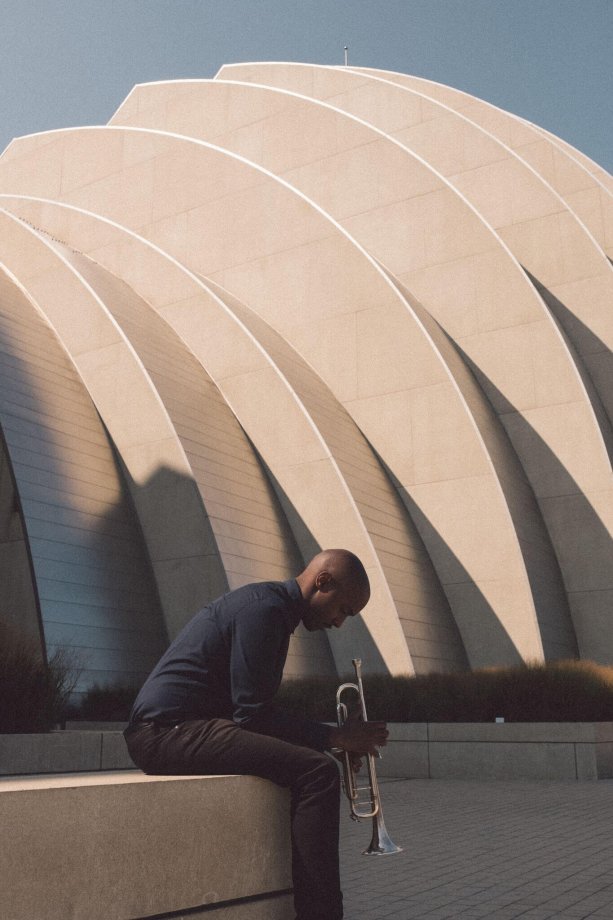Kind Of Bleu: Musician Hermon Mehari Makes His Debut
For jazz trumpeter and Missouri native Hermon Mehari, the answer is simple: International Klein Blue. He first saw it at an exhibit of photographs by Helena Almeida at Paris’ Galerie nationale du Jeu de Paume, where he went searching for inspiration for his first studio album as a bandleader. What he saw riveted him. Black-and-white self-portraits of the artist had been activated by washes of vivid blue paint: blue extending from her open hands, blue spiraling out of her open mouth.“And I said, ‘This! This is what I want for the album,” Mehari told me. “I want this color to be in the music.”The album that resulted, “Bleu,” can stop you in your tracks, too. It’s a product of years of work, but also real inspiration; an expansive love letter to Mehari’s adopted hometown of Kansas City and the global life it has helped the 29-year-old build beyond it. In 10 songs, Mehari blends Kansas City’s particular breed of bluesy, fluid jazz with surprising moments of neo-soul, instrumental hip-hop and the global influences he’s gathered over his years as a touring musician. Listen close, and you’ll hear an abstracted version of the story of how he came to be standing in that Paris gallery anointed one of the best horn players to come out of the Midwest this millennium.Mehari was born in Jefferson City, Missouri, to Eritrean parents, and he found jazz young. As a 14-year-old at music camp, a teacher invited him, for the first time, to put down the sheet music and improvise. “Improv is about as personal as it can get,” says Mehari. “Having a voice through the music, especially at that age, is so exciting.”Most teens would just keep playing. Instead, young Mehari rushed to the record store. He bought the first album that caught his eye: fittingly, Miles Davis’ “Kind of Blue.” Charlie Parker followed soon after.“I just wanted to know, sonically, ‘How do they do this? How do they make these sounds with their instruments?’” Mehari pondered. “And then I started listening to more and more, and I found out that they weren’t just great—they were revolutionary. They changed what music was.”Mehari applied to the University of Missouri-Kansas City, mainly because it meant the chance to study with jazz legend Bobby Watson. Mehari had already been accepted to Eastman School of Music and Berklee College of Music when Watson called to tell him he was admitted to UMKC. “I was sitting in my bedroom when I picked up the phone, and I looked down and there was an Art Blakey record featuring Bobby Watson sitting on my nightstand,” Mehari laughs. “I said, ‘Well, I guess I have to go here, then!’”Jazz is a music of intense, fluid relationships: trumpet answering sax, keys in conversation with the drum kit. So, it’s no surprise that Mehari’s years at UMKC yielded not just a degree, but also a deep bond with Watson. “Jazz is street music not academic music,” Mehari says. “It’s a really personal thing, and so the teaching is personal, too. There’s a lot of tough love, a lot of intense learning. Your teachers become your father figures, your collaborators, your friends.”With the equally dynamic partnerships he formed with classmates and continuous collaborators, like Ryan Lee and Peter Schlamb, Mehari had the ingredients for his first bands—jazz quartet Diverse, as well as a sprawling, 11-piece pop group, The Buhs. Soon, he found himself with recording contracts before he’d even graduated.But Mehari had other ambitions: to be a bandleader, and to express that voice he’d found all those years ago in a middle-school music room. He competed in trumpet competitions, playing anonymously behind a curtain for a panel of unseen judges, and he often won: he’s a title-holder of the Carmine Caruso International prize.He honed a voice on the horn that you can recognize blindly. “I don’t play like a lot of trumpet players. My biggest influences are actually saxophone players.”And he kept writing songs.Mehari’s music has taken him all over the world—these days, he’s splitting his time between Kansas City and Paris, with frequent shows in places as far-flung as Amsterdam and Tokyo—and his songs have come to him all over the world. “I’ll be in whatever city, and a melody will just come into my head,” he says. “Once I was walking in Buttes-Chaumont park and that happened. That became the last track on ‘Bleu.’”The lifestyle has made him a little less monkish these days, too. He loves coffee and photography, as well as questing for the world’s best food. He says he listens to less jazz than hip-hop. Future is a favorite.It’s fitting; the future is what Mehari wants his contribution to the jazz world to be, too. “To me, the tradition of this music has always been to innovate, to move forward. I mean, the thing that defines whole decades is their music, the unique sounds that each era has,” he says. “Jazz—and my music—has to be part of the next phase.” This story originally appeared in ALIVE Issue 6, 2017. Purchase Issue 6 and become an ALIVE subscriber.Photography by Attilio D’Agostino.


